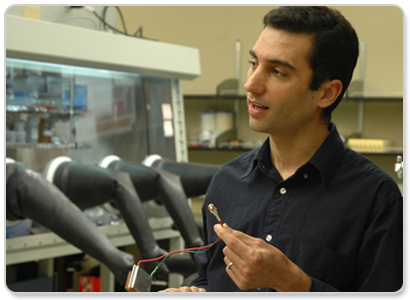OSU-Tulsa Researcher Developing Technology to Generate Power from Waste Heat
Thursday, August 13, 2009

Vashaee’s research has recently attracted the attention of national research agencies.
He has been awarded a five-year, $700,000 grant from the Air Force Office of Scientific
Research (AFOSR) and a three-year, $200,000 grant from the National Science Foundation
(NSF) to perform research associated with thermoelectrics. Both grants will begin
in September.
“Nearly 60 percent of the world’s useful energy is wasted as heat. Thermoelectric
materials have the potential to directly convert waste heat into electrical energy,”
Vashaee says. “Development of highly efficient, inexpensive thermoelectric materials
is a key to reduce both energy consumption and harmful emissions on a large scale.”
Inside his lab in OSU-Tulsa’s Helmerich Advanced Technology Research Center, Vashaee
and his engineering graduate students will use the AFOSR grant to develop thermoelectric
materials that will harvest wasted energy from military aircraft.
Vashaee said with the use of thermoelectric materials, heat emissions from an aircraft’s
engine exhaust and the temperature difference between the interior and exterior of
a plane could create a potential source of electrical energy.
“The harvesting of energy from waste heat and temperature differential could supplement
the internal power supply for aircraft, much like a hybrid car.” Vashaee said. “It
creates a more efficient and inexpensive energy source and the thermoelectric materials
are very robust. They almost last forever.”
Dr. Kenneth Ede, assistant dean of OSU’s College of Engineering, Architecture and
Technology, says it’s the material’s toughness and relatively low-cost that make it
a very attractive alternative to solar energy technology.
“Thermoelectric materials are so much less expensive than the current solar materials.
At one-fifth of the cost, thermoelectric materials are one of science’s best kept
secrets,” Ede said. “We’re very excited about Dr. Vashaee’s research and its potential
for future environmentally friendly household and everyday applications.”
Vashaee said thermoelectric materials can be developed for a variety of uses from
utilizing body heat to power a pacemaker to providing soldiers with lightweight, climate-controlled
fatigues and night-vision enhanced helmets. He also illustrated the concept by explaining
how harvesting the excess heat in a home’s attic could be converted to power that
would efficiently and economically heat and cool the entire house.
Vashaee believes all of these solutions could be made possible by using nanostructured
thermoelectric materials to convert already existing solar or body heat into electrical
energy.
OSU-Tulsa President Gary Trennepohl said Vashaee’s research is an impressive example
of the extraordinary work in nanotechnology happening in OSU-Tulsa’s Helmerich research
center.
“Research in our Helmerich ATRC focuses on materials science and nanotechnology is
a key component. It’s because we can conduct research at the nano level, that Dr.
Vashaee can pursue advances in waste heat recovery,” Trennepohl said. “OSU-Tulsa’s
faculty are passionate about teaching students, generating ideas and creating innovative
technologies.”
Vashaee will use the NSF grant to combine theory and experiments in developing a capability
to predict the relevant properties of thermoelectric nanocomposite materials, essentially
providing the theoretical groundwork used by future researchers.
Vashaee is an assistant professor of electrical and computer engineering. He came
to OSU-Tulsa in September 2007 from the Massachusetts Institute of Technology.
